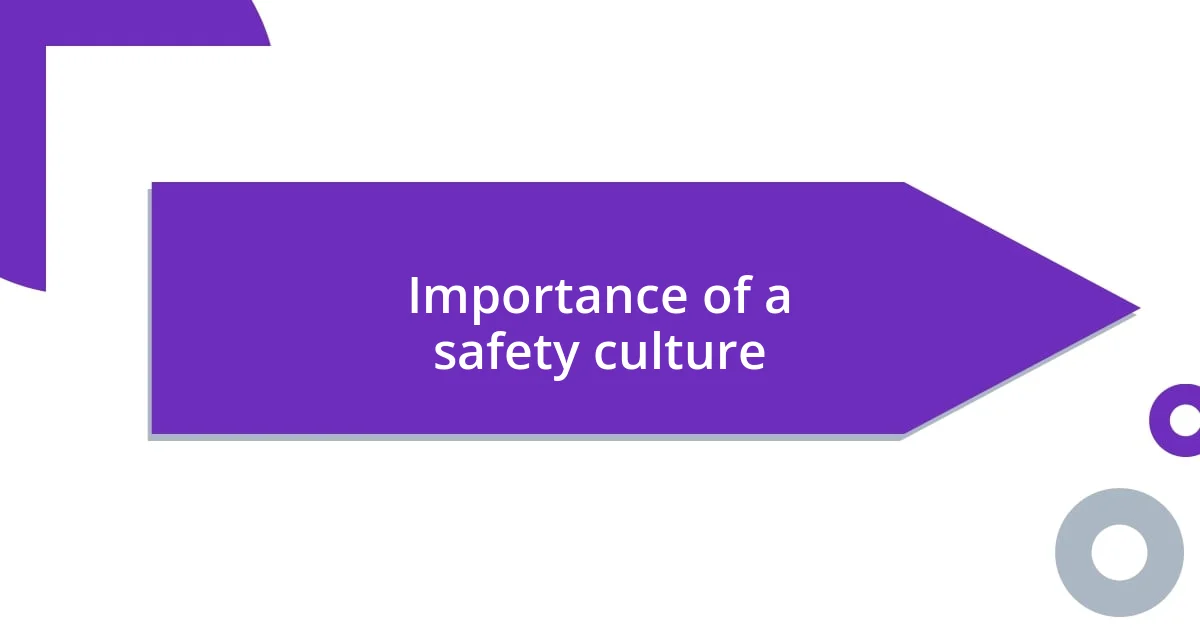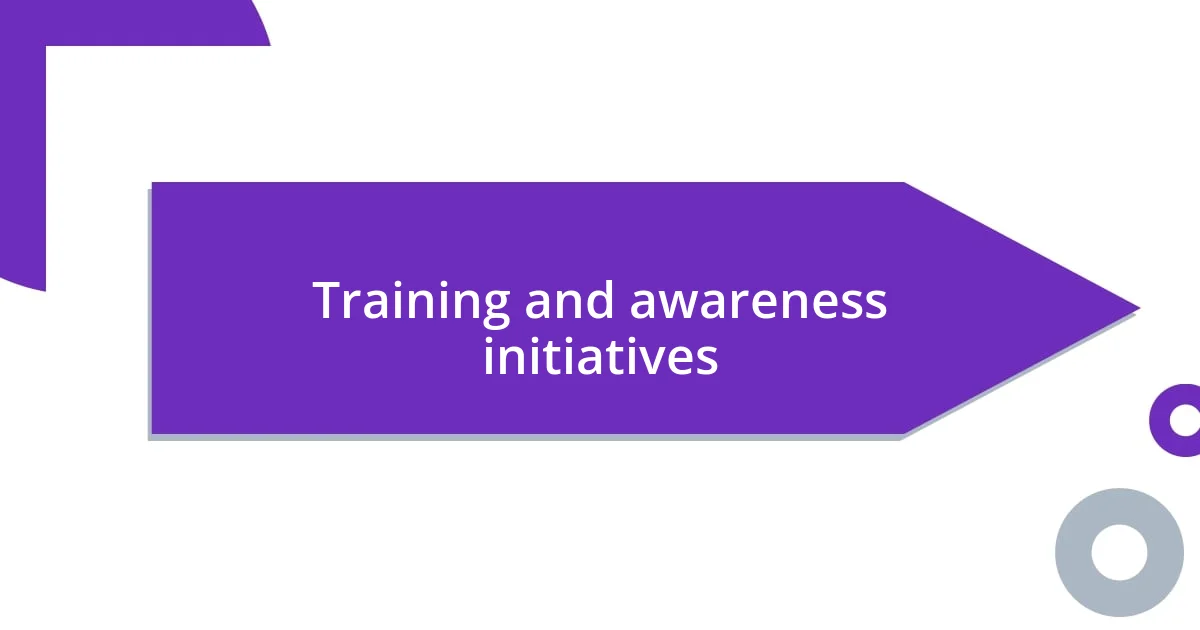Key takeaways:
- Safety culture is about shared beliefs and open communication, fostering an environment where everyone feels empowered to speak up and manage risks collectively.
- Key components of a strong safety culture include leadership commitment, employee involvement, and effective communication, which together create a proactive approach to safety.
- Engaging employees through initiatives like safety committees, regular safety huddles, and recognition of safe behaviors enhances ownership and enhances the overall safety culture in the workplace.

Understanding safety culture
When I think about safety culture, I remember a time at work when an unexpected incident shook us all. It was a reminder that safety isn’t just about following rules; it’s about fostering an environment where everyone feels empowered to speak up. Isn’t it fascinating how a single voice can shift the dynamics of a whole workplace?
Understanding safety culture is more than just recognizing policies; it’s about the shared beliefs and attitudes that drive our actions. For instance, in my experience, when team members prioritize open communication, it not only builds trust but also enhances our collective ability to manage risks. Have you ever noticed how a supportive atmosphere makes you more alert and engaged?
Another aspect of safety culture is acknowledging that it evolves constantly. I once worked in a team where we regularly reflected on our practices, learning from both successes and mistakes. This ongoing dialogue created a culture where safety was not just a checkbox; it became a shared value. How often do we pause to reflect on our experiences to shape a better safety mindset?

Importance of a safety culture
A strong safety culture isn’t just important; it’s vital for every organization. I remember a project where a minor oversight could have led to serious consequences; luckily, our proactive safety culture encouraged everyone to voice concerns. That experience reinforced my belief that when employees feel safe sharing their thoughts, it creates an environment where incidents can be significantly reduced.
- Enhances teamwork and communication.
- Builds trust between management and employees.
- Reduces workplace injuries and accidents.
- Promotes a proactive approach to risk management.
- Encourages continuous learning and improvement.
I’ve seen firsthand how companies that prioritize safety culture tend to be more successful overall. Once, during a team meeting, we discussed a near-miss incident. Rather than point fingers, we focused on solutions, transforming a scary moment into a learning opportunity. This shift truly highlighted to me how a solid safety culture fosters resilience and adaptability among team members. It’s about more than rules; it’s about our collective commitment to looking out for one another.

Key components of safety culture
Key components of safety culture intertwine to form a robust framework. One vital aspect is leadership commitment. In my experience, I’ve found that when leaders visibly prioritize safety, it resonates throughout the organization. I recall a time when our department head adjusted schedules to allow for safety training. That action spoke volumes; it showed us that safety wasn’t just an afterthought but a core value. How does your leadership demonstrate commitment to safety?
Another critical component is employee involvement. I remember a safety initiative where our team was encouraged to participate in risk assessments. What struck me was how engaged everyone became, sharing suggestions based on their frontline experiences. This approach not only boosted morale but also led to tangible improvements in our processes. It’s enlightening to see how fostering a collective responsibility transforms individual perspectives on safety. Don’t you think that drawing from diverse insights makes a safety culture stronger?
Finally, effective communication is a cornerstone of safety culture. I’ve often witnessed how open dialogue regarding safety concerns creates an atmosphere of trust. During one project, we implemented a suggestion system, allowing anyone to voice potential hazards anonymously. This initiative uncovered issues we hadn’t even considered, leading to actionable changes. It’s incredible how a simple mechanism can drive significant safety improvements. Have you ever participated in a system that made it easier to raise concerns? It could really shape your perception of safety culture.
| Component | Description |
|---|---|
| Leadership Commitment | Visible prioritization of safety by leaders to inspire the organization. |
| Employee Involvement | Encouraging team participation in safety initiatives to enhance morale and insights. |
| Effective Communication | Fostering open dialogue about safety concerns to build trust and drive improvements. |

Steps to foster safety culture
Creating a robust safety culture begins with establishing clear and accessible safety protocols. I remember rolling out a new safety manual at my previous job; the process wasn’t just about handing out paperwork, but rather hosting workshops to discuss the procedures in detail. Seeing my colleagues engaged and asking questions made me realize how crucial it is for everyone to fully understand the guidelines that keep us safe. Have you ever found yourself confused by safety protocols? Making sure they are communicated effectively can really change how people perceive their importance.
Another essential step is recognizing and rewarding safe behaviors. A few months into a safety initiative at my workplace, we started acknowledging team members who practiced safety diligently. One week, a colleague received a shout-out for using proper PPE (Personal Protective Equipment) consistently during a demanding project. That recognition not only motivated others but also created a ripple effect—people started taking pride in playing their part in maintaining safety standards. Don’t you think that celebrating safety achievements can inspire a collective effort?
Training isn’t just a one-time event; it’s an ongoing journey that needs to adapt to evolving challenges. I once participated in refresher safety courses that incorporated virtual reality simulations of emergency scenarios. The experience was intense but incredibly valuable; it’s amazing how hands-on training boosts confidence and preparedness in real-life situations. I often ask myself, would I feel as equipped to respond without that immersive experience? Continuous training helps nurture a proactive attitude, enabling everyone to act swiftly when safety is at stake.

Training and awareness initiatives
Training and awareness initiatives are absolutely critical in cultivating a safety culture. I recall a time when our organization introduced a monthly safety workshop, where unexpected scenarios were role-played. I remember feeling a mix of excitement and apprehension as we tackled potential hazards in real time. It was eye-opening to witness colleagues step out of their comfort zones, which not only heightened their awareness but also fostered a sense of camaraderie. Don’t you think that practicing these skills ahead of time prepares everyone for real emergencies?
Additionally, integrating technology into training has been a game changer. In one instance, we adopted an app that provided bite-sized safety lessons and instant quizzes. I would often find myself scrolling through these short, engaging modules during breaks. This allowed me to absorb vital information without feeling overwhelmed. It’s intriguing how technology can facilitate learning in such digestible ways, right? It really underscores the point that training should be flexible and tailored to fit our busy lives.
Another impactful initiative I experienced was the “Safety Ambassador” program. A few of my colleagues volunteered to lead discussions and present safety tips in team meetings. Their enthusiasm was contagious, and I could sense how much pride they took in their roles. Watching them advocate for safety sparked discussions and made everyone feel more comfortable sharing their ideas and concerns. Doesn’t it make a difference when peers champion safety collectively? It’s moments like these that emphasize the importance of peer-led initiatives in reinforcing a strong safety culture.

Engaging employees in safety
Engaging employees in safety truly involves creating opportunities for everyone to share their thoughts. I remember one particular brainstorming session where team members were encouraged to voice safety concerns openly. It was incredible how the conversation flowed; people felt safe to express themselves, which unveiled valuable perspectives that management hadn’t considered. Have you ever noticed how empowering it is to be part of a solution? When employees contribute ideas, they are more likely to feel a sense of ownership over safety practices.
Another effective way to engage employees is by implementing safety committees made up of volunteers from various departments. I was fortunate enough to be part of one, and we met regularly to discuss safety audits and develop new initiatives. This experience opened my eyes to the diverse viewpoints that come from different roles within the company. Have you ever thought about how a variety of perspectives can enrich safety discussions? Collaborating across functions not only fosters teamwork but also leads to more rounded approaches to safety challenges.
Lastly, I’ve found that regular safety huddles can be instrumental in keeping safety front of mind. I vividly remember the energy during our quick morning meetings; we would review any incidents from the previous day and discuss solutions as a team. This constant reinforcement helped cultivate a culture where safety wasn’t just a set of rules, but a shared responsibility. Isn’t it amazing how a few minutes each day can transform workplace attitudes towards safety? These huddles turned out to be not just informative but also a bonding experience for our team, solidifying our commitment to each other’s safety.

Measuring safety culture effectiveness
Measuring the effectiveness of a safety culture can sometimes feel like navigating a foggy road. One method I found particularly enriching was gathering anonymous feedback through surveys. I remember the first time we implemented this approach; it felt a bit intimidating at first. However, when the results came in, it was enlightening to see how many employees shared the same concerns and ideas for improvement. It’s amazing how anonymity can encourage honesty—don’t you think people are often more candid when they don’t feel scrutinized?
Another insightful tool I’ve come across is workplace incident reporting analysis. I recall one instance where we meticulously studied near-misses over a quarter. What struck me was how seemingly small incidents could reveal underlying safety issues—like that time when a colleague slipped simply because their shoes weren’t suited for the environment. By discussing these reports openly, we turned what could have been brushed aside into valuable learning opportunities. It really makes you wonder, how can we expect to improve without digging into the messiness of our safety practices?
Lastly, I think observing behavioral changes over time offers a compelling measure of safety culture. During one project, I initiated a weekly “safety spotlight” where we celebrated individuals who demonstrated exemplary safety practices. The shift in the atmosphere was palpable; it wasn’t just about acknowledgment, but it sparked a friendly competition among teams to prioritize safety. Have you ever experienced how recognition can light a fire in people? By watching how leaders and peers responded, we could gauge the health of our safety culture in real time.














